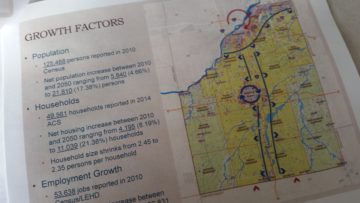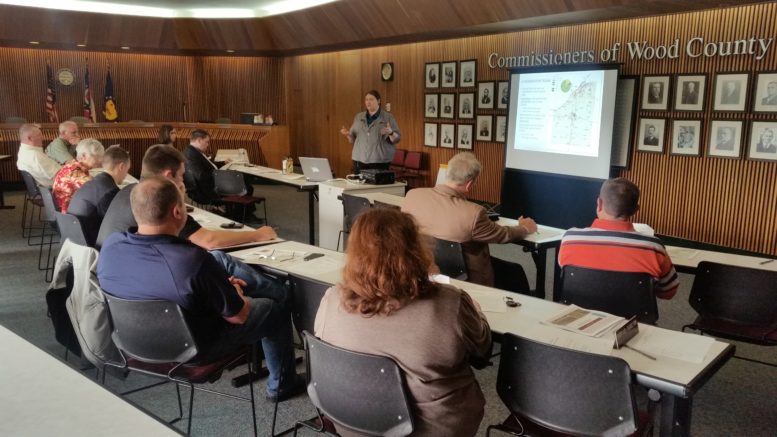By JAN LARSON McLAUGHLIN
BG Independent News
Wood County faces inevitable growing pains over the next couple decades. So a new land use plan is examining how the county can ease those pains by saving prime farmland, directing development, protecting waterways, and possibly establishing an energy corridor for pipelines.
Input on the planning process was sought Wednesday evening.
“Do you all feel this is the right direction for us to be heading,” asked Emily Crow, the consultant working with the Wood County Planning Commission on the land use plan. “We’re trying to balance the discussion where there are pressures for growth.”
The countywide plan is just the first step. Then the townships will be asked to implement the vision through zoning.
“That’s where the rubber meets the road and things actually happen,” Crow said.
To prepare for the future, the plan first gives a snapshot of Wood County today. Agriculture continues to be the biggest land use, with more than 76 percent of the acreage in the county used in farming. Commercial uses are located primarily along major transportation corridors.
Then projections were made for the future. By 2050, the county’s population of 125,488 is expected to increase anywhere from 5,840 on the conservative side to 21,810 on the high side.

Map showing projected land use plans
Employment, now at 53,638 jobs according to the 2010 Census, may grow by as many as 39,849 jobs by 2050.
“You are gaining a lot more jobs than you are population,” Crow said. The biggest growth is expected in retail trade and warehousing.
The county is already facing housing demands that aren’t being met, she said. In 2014, the county had 53,840 houses, with approximately 7 to 9 percent being vacant. But buyers are looking for newer homes.
“You have a demand in the market for new housing stock,” Crow said.
Catalysts for business growth include the capacity and access improvements being made to Interstate 75 and the CSX rail hub in the southern end of the county. The county appears to have a good supply of land already zoned for commercial and industrial uses.
So what happens as the county grows?
“You have increasing land value for your agricultural areas,” which may be an incentive for some farmers to sell land for development, Crow said. “It’s a consideration. How do we maintain that agricultural base for the county?”
Demands for sanitary sewer and good water services will increase, and drainage systems will have to change to accommodate growth.
Development is most likely in Troy Township and Middleton Township, where utilities and zoning are in place for industrial growth. Though water and sewer have been extended to the southwestern corner of the county, that area is most likely to remain agricultural, except of the land near the CSX hub.
“There’s no fear we’re going to run out of land to support all the growth that’s going to happen,” Crow said.
Crow pointed out that the growth forecasts for Wood County took into account neighboring counties. “We didn’t look at Wood County in a bubble.”
When the draft plan is completed, another public meeting will be held.
Following are the guiding principles in the land use plan:
- Agriculture: Farming is part of the county’s heritage and a fundamental component of economy. The plan will protect prime farmland and support agriculture production.
- Growth: While development demand is anticipated to continue in Wood County, the actual population and employment growth in the Toledo region are expected to be flat through the next 20 years. The plan will make efforts to promote redevelopment and reinvestment in areas with existing infrastructure and services, and strategically manage outward expansion of suburban development in townships with the greatest growth pressures.
- Declining rural population: Many of the rural townships are experiencing a decline in population as farms are consolidated and homes in rural areas and some villages are left vacant. The plan will evaluate road maintenance and utility provision policies to reflect the shrinking demand on infrastructure.
- Employment and economic development: Employment is expected to continue growing in Wood County as it captures a bigger share of the region’s population and employment. The county’s significant transportation infrastructure provides an attractive location for distribution and warehousing. The plan will identify large businesses in strategic locations such as Lake and Troy townships, and Henry Township near the CSX rail hub.
- Non-residential reinvestment: The northern townships have a significant supply of older underutilized structures and land zoned for commercial and industrial uses. Reinvestment in these corridors will be encouraged.
- Residential demand and housing supply: The current housing market in Wood County is favoring luxury single-family construction, while older neighborhoods are showing a decline in population, indicating that older housing stock may not be meeting the needs of the current population. The plan will designate land for residential growth and encourage reinvestment in older neighborhoods.
- Energy corridor: There are four pipelines being proposed to crisscross Wood County. Some will cut through populated areas and could render thousands of acres vulnerable to leaks and construction. The plan will look at the possibility of an energy corridor for pipelines.
- Stormwater, run-off and water quality: The county’s surface water is impacted by development and agricultural practices, and is managed in the county’s system of drainage channels that lead to the Maumee River and Lake Erie. The plan will take into consideration drainage patterns and water quality.
- Recreation and conservation of natural and cultural resources: As the county’s population grows, the demand for parks and public open spaces increases. The plan will include provisions to reserve open space, sites of cultural and natural heritage, and provide parks and trails.
- Character and quality of growth: As townships continue to experience growth pressures and demand for new development the character and quality of the growth is important. Modern methods for regulations and zoning will be encouraged.

